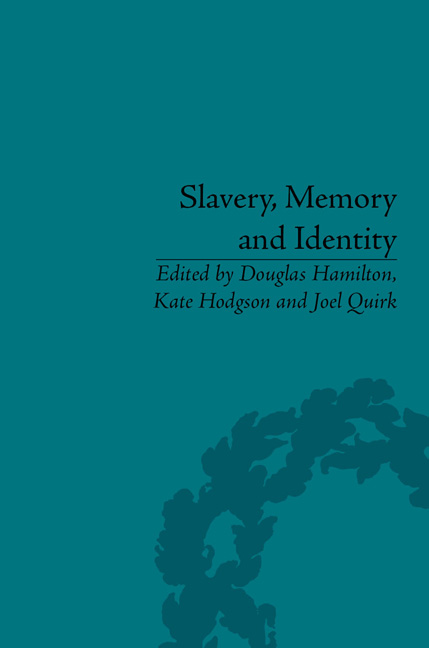Book contents
- Frontmatter
- CONTENTS
- Acknowledgements
- List of Contributors
- Introduction: Slavery, Memory and Identity: National Representations and Global Legacies
- 1 ‘A Thoroughly National Work’: The Politics of Blame and European Abolitionist Identities
- 2 From Slave Quarters to Wigwams: Native American Slaveholding and the Debate over Civilization
- 3 For Civilization's Sake: Legal Abolition of Slavery in Nepal and Sierra Leone in a Global Perspective, 1920–30
- 4 The Heritage of Slavery and Nation Building: A Comparison of South Africa and Mauritius
- 5 Picturing Slavery: The Perils and Promise of Representations of Slavery in the United States, the Bahamas and England
- 6 ‘History Must be Re-Written!’: Revisionist Ambitions among West African Slave Descendants
- 7 Contrapuntal Memories of Slavery and Abolition in the French-Speaking World
- 8 Public Memory of Slavery in Brazil
- 9 Learning to Remember and Imagine Slavery: The Pedagogies of Museum Field Trips in the Representation of ‘Difficult’ Histories
- 10 Slavery and Racism as the ‘Wrongs’ of (European) History: Reflections from a Study on Portuguese Textbooks
- Notes
- Index
5 - Picturing Slavery: The Perils and Promise of Representations of Slavery in the United States, the Bahamas and England
- Frontmatter
- CONTENTS
- Acknowledgements
- List of Contributors
- Introduction: Slavery, Memory and Identity: National Representations and Global Legacies
- 1 ‘A Thoroughly National Work’: The Politics of Blame and European Abolitionist Identities
- 2 From Slave Quarters to Wigwams: Native American Slaveholding and the Debate over Civilization
- 3 For Civilization's Sake: Legal Abolition of Slavery in Nepal and Sierra Leone in a Global Perspective, 1920–30
- 4 The Heritage of Slavery and Nation Building: A Comparison of South Africa and Mauritius
- 5 Picturing Slavery: The Perils and Promise of Representations of Slavery in the United States, the Bahamas and England
- 6 ‘History Must be Re-Written!’: Revisionist Ambitions among West African Slave Descendants
- 7 Contrapuntal Memories of Slavery and Abolition in the French-Speaking World
- 8 Public Memory of Slavery in Brazil
- 9 Learning to Remember and Imagine Slavery: The Pedagogies of Museum Field Trips in the Representation of ‘Difficult’ Histories
- 10 Slavery and Racism as the ‘Wrongs’ of (European) History: Reflections from a Study on Portuguese Textbooks
- Notes
- Index
Summary
On a crowded New York City street, a moving truck features a cartoon image of Harriet Tubman, the African-American abolitionist and leader of the Underground Railroad, as an advertisement to promote tourism to Canada. The advert boasts that Canada abolished slavery long before the United States; the image further informs observers that Canada was the ‘promised land’ for fugitive slaves, escaping from the plantation South.
In New York City, where the most prominent reference to its slave past lies in an outdoor memorial space made of granite and stone, which once served as a burial ground for slaves, the image of Tubman on a moving truck offers the only visual, human representation of slavery. Yet this image of abolition and freedom belies the history of slavery in New York. Making Tubman a part of an advertising campaign promoting Canadian tourism not only raises ethical and historically questionable issues, but it also has the unintended effect of suggesting that most enslaved people escaped from slavery and eventually found their way to freedom. Conversely, as the existence of the African Burial Ground reveals, thousands of slaves died in New York and were never granted their freedom. In fact, their experience defies representation; the only remnant left to commemorate their existence is a symbolic mound of elevated dirt in the centre of Lower Manhattan.
This chapter investigates the clash between the efforts of museum curators, historians and the public to represent slavery through pictorial images. I argue that the effort to represent slavery – as the case of Tubman reveals – often obscures the brutality and violence of slavery and redirects contemporary viewers to more sanguine and uplifting images that do not risk indicting the nation or those who profited from enslavement. In keeping with the theme of violence during slavery, this chapter posits a theoretical approach in response to the limitations of historic landmarks and museum exhibitions to capture the violence that slavery engendered.
- Type
- Chapter
- Information
- Slavery, Memory and IdentityNational Representations and Global Legacies, pp. 77 - 90Publisher: Pickering & ChattoFirst published in: 2014



